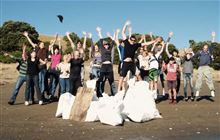Kahutara kids caring for Onoke Spit
Archived content: This media release was accurate on the date of publication.
Introduction
Forty hard working Kahutara School students joined a community group last Friday to work on a native planting in one of Wairarapa’s toughest environments – Onoke Spit.Date: 31 May 2018
The two kilometre spit of public conservation land is made up of coarse sand battered by the swells of Palliser Bay, regular gales from the Remutaka Ranges and inundation from Lake Onoke.
Despite the tough conditions, Onoke Spit has its own collection of hardy native animals and plants, with a few rare species, such as the Caspian tern and native sand tussock.
Local residents Denise and Dougal MacKenzie co-ordinate the Friends of Onoke Spit that began planting native plants at the spit in 2010.
Kahutara School pupils have been involved for the past eight years in weeding and mulching the plantings and putting new native plants in the ground that are suited to the environment.
This year the pupils, the friends and staff from the Department of Conservation and Greater Wellington Regional Council planted 400 taupata, salt-marsh ribbonwood, oioi (jointed rush) and harakeke (flax).
Mrs MacKenzie said introduced weeds such as gorse threaten to take over the spit and the goal is to remove the weeds and replace them with native plants.
"Gorse has been here for 50 years and it will take 50 years to get rid of it. It's important to get the kids involved. Us oldies won't be around in 50 years."
Mrs MacKenzie said choosing the right plants for the conditions is essential, as they have to deal with salt-laden winds, drought and flooding.
"We know we will never get a forest. We want native ground cover for our lizards and birds."
The low growing plants and open sand provide breeding habitat for native banded dotterels, Caspian terns, white fronted terns, variable oyster catchers and the occasional little blue penguin.
While the plants and animals have evolved to deal with the elements, they have less success dealing with introduced predators and recreational vehicles.
Introduced predators make a meal of eggs, chicks and any adult birds they can catch, while tyres tear up plants and crush nests and eggs.
Mr MacKenzie runs 120 predator traps on the spit and adjacent land to help protect the birds, catching stoats, rats, hedgehogs, ferrets and a surprising number of feral cats.
The group has fenced sensitive areas high on the beach and liaises with four-wheel drive clubs to encourage their members to avoid the sensitive areas.
Mr MacKenzie said drivers can avoid causing damage by staying below the highwater mark, both on the lake and seaward side.
For more information: NatureSpace.org
Contact
Jim Flack, Ranger, Wairarapa
Mobile: +64 027 568 9246
Email: jflack@doc.govt.nz


